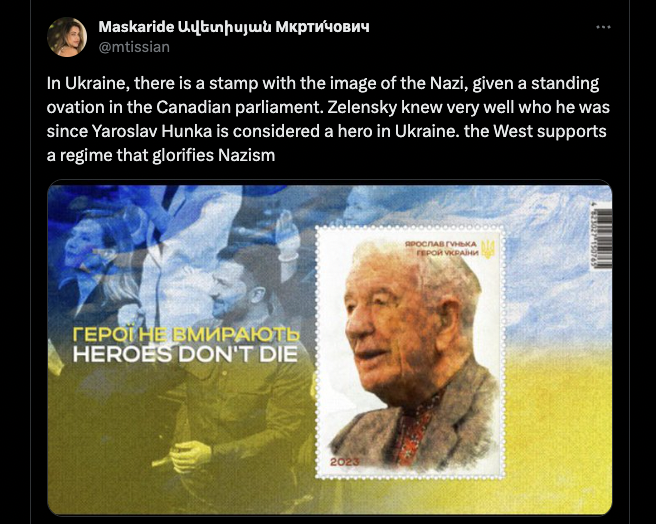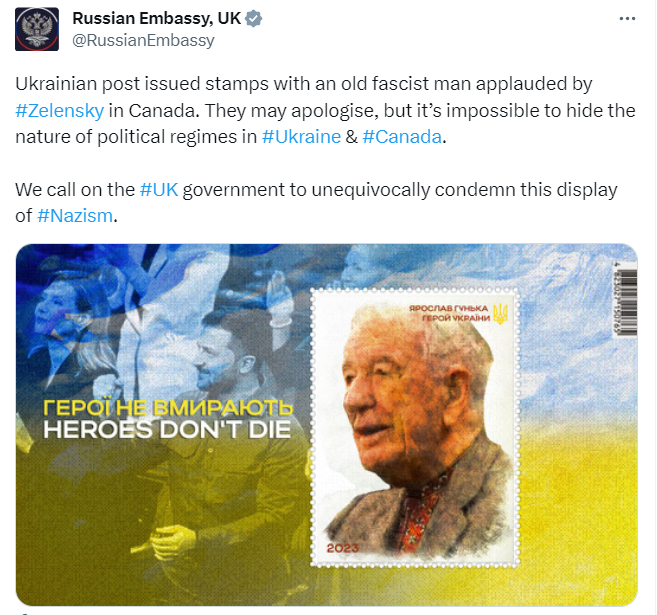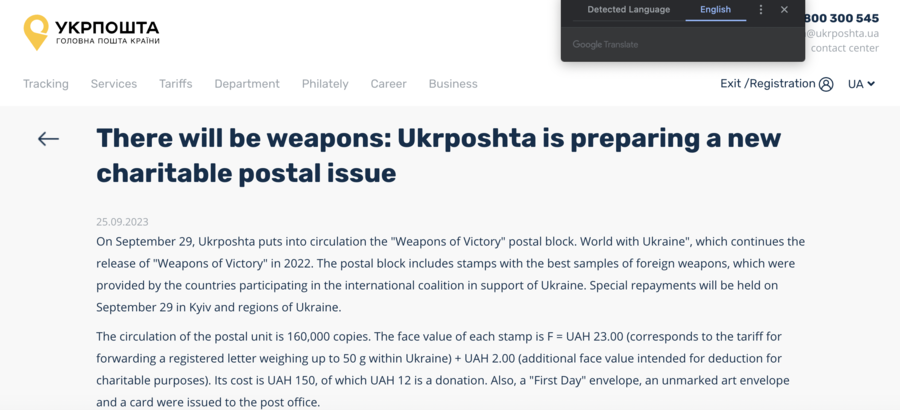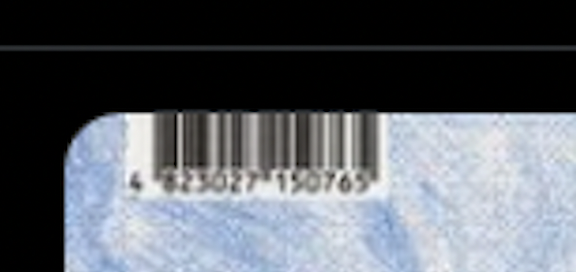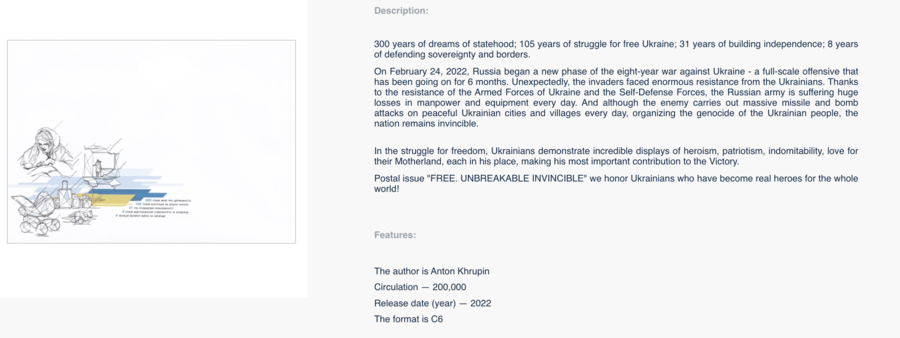Fact Check: Ukraine Did NOT Issue Stamp With Yaroslav Hunka On It — Viral Image Showed Barcode From Different Product

Did Ukraine issue a stamp with an “image of the Nazi” who was “given a standing ovation in the Canadian Parliament” to recognize Yaroslav Hunka as Ukraine’s national hero? No, that’s not true: The website of the Ukrainian national postal service does not contain any mentions of the supposed stamp. Furthermore, the image shared on social media contained a barcode linked to a different item: an envelope showing a crying woman that was issued for Ukraine’s Independence Day in 2022.
The controversial episode involving Hunka, who served in a German SS division during World War II, took place in the Canadian House of Commons during the visit of Ukrainian President Volodymyr Zelenskyy on September 22, 2023.
The claim appeared in a post (archived here) on X, formerly known as Twitter, on September 26, 2023. It opened:
In Ukraine, there is a stamp with the image of the Nazi, given a standing ovation in the Canadian parliament. Zelensky knew very well who he was since Yaroslav Hunka is considered a hero in Ukraine. the West supports a regime that glorifies Nazism
This is what the post looked like on X at the time of writing:
(Source: X screenshot taken on Wed Sep 27 21:13:56 2023 UTC)
The story originated from a post by the Russian Embassy in the U.K. Later, that post was deleted but Lead Stories saved a screenshot:
(Source: X screenshot taken on Tue Sep 26 01:45 2023 UTC)
The shared image showed what looked like a 2023 postal stamp displaying an old man. A small inscription in red in the top right corner said in Ukrainian:
Yaroslav Hunka
Hero of Ukraine
The background of the image in question was tinted in Ukrainian national colors applied on top of the picture of Zelenskyy and his wife.
However, as of this writing, the most recent press release on the website of the Ukrainian national postal service (Ukrposhta), discussed the upcoming premiere of brand-new stamps showing Western weapons, not any particular person, as seen on the screenshot below automatically translated to English:
(Source: Ukrposhta screenshot taken on Wed Sep 27 17:03:25 2023 UTC)
The list of already released stamps did not include the one with Hunka on it.
The image shared on social media contained a barcode:
(Source: X screenshot taken on Wed Sep 27 16:16:09 2023 UTC)
According to Barcodelookup.com, this combination of digits is associated with a different product:
(Source: BarcodeLookup screenshot taken on Wed Sep 27 17:21:25 2023 UTC)
The envelope under the same title can be found on the Ukrposhta website:
(Source: Ukrposhta screenshot taken on Wed Sep 27 15:14:30 2023 UTC)
Zelenskyy spoke before the Canadian Parliament on September 22, 2023. During this visit, the speaker of Canada’s House of Commons, Anthony Rota, introduced a 98-year-old man named Yaroslav Hunka as a “veteran from WWII who fought the Ukrainian independence against the Russians.” That was followed by a round of applause, and Zelenskyy clapped, too.
On September 24, 2022, Friends of Simon Wiesenthal Center issued a statement (archived here) pointing out that Hunka served in the 14th Waffen Grenadier Division of the SS, also known as Galicia:
The fact that a veteran who served in a Nazi military unit was invited to and given a standing ovation in Parliament is shocking.
Rota admitted responsibility for inviting Hunka, apologized and resigned on September 26, 2023, in the aftermath of the controversy.
The Kremlin, which compared today’s Ukraine with the Nazi Germany of WWII to justify its invasion of Ukraine in 2022, described the incident as “outrageous.”
The Schutzstaffel, or SS, was a Nazi party’s paramilitary organization that started in the 1920s as a small guard unit of Hitler’s supporters and grew into a vast structure during WWII. The Nuremberg Tribunal outlawed the SS as a criminal organization, and many other postwar trials further revealed that many of the units (for example, Einsatzgruppen) constituting this organization were involved in war crimes, mass murders of civilians and the perpetration of the Holocaust.
At the end of the war, a significant part of the SS Galicia managed to emigrate to Western countries. After spending several years in camps in Italy and Britain, they were cleared for immigration to Canada in the 1950s.
In the late 1980s, Canada re-investigated SS Galicia and concluded that its former members couldn’t be indicted as a group for war crimes. The commission stated that those people were individually screened before admission and that they didn’t hide their involvement with the unit, thus not committing immigration fraud.
A document explaining that approach — still available on the Canadian government website, as of this writing — said that association with the unit formed from ethnic Ukrainians who, as described, saw that as an opportunity to fight against the Soviet rule is not enough to constitute a war crime without additional evidence incriminating its individual members:
If the only allegation against a resident of Canada is that he was a member of the Galician Division, that is not an individual which we consider should be made the subject of an investigation by your Commission. If the allegation is that while he was a member of the Division, he committed atrocities at such-and-such a place, if there is evidence of the committing of atrocities alleged in the information which was conveyed us, then that person becomes of interest to your Commission. We have not before, and will not tomorrow, undertake to rewrite history.
Contrary to the claim on social media, however, the current government in Ukraine does not recognize members of SS Galicia as national heroes. In 2021, Zelenskyy, already the president, and Ukraine’s Ministry of Foreign Affairs condemned an event in Kyiv aimed at commemorating the unit, and even Russian state-controlled RIA Novosti (archived here) reported that.
Other Lead Stories fact checks about the war in Ukraine can be found here.
This article has been archived for your research. The original version from Lead Stories can be found here.
